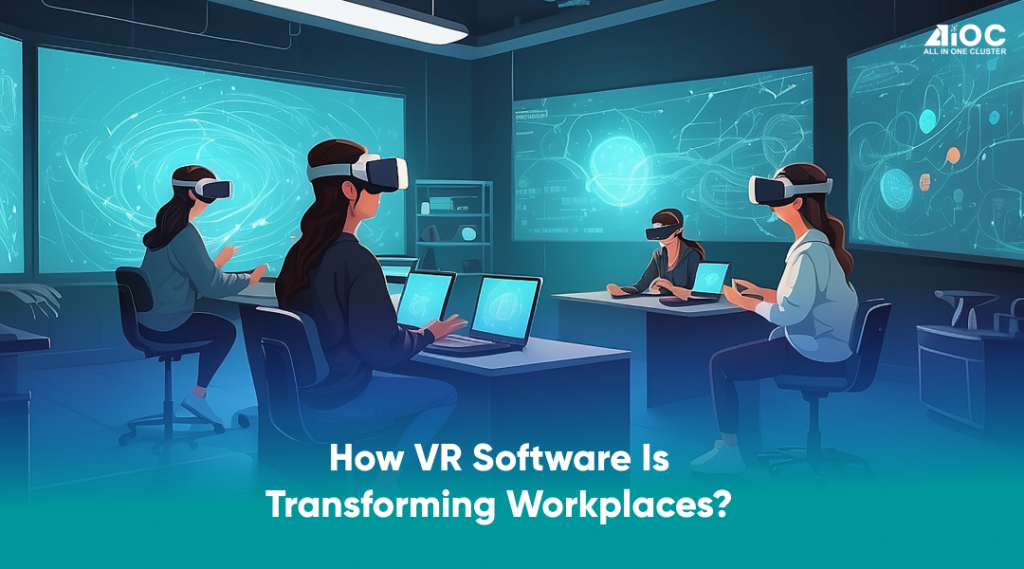In the fast-paced world of technology, Virtual Reality (VR) has emerged as a game-changer, transforming the way we work and collaborate. VR software, with its immersive capabilities, is reshaping traditional workplaces and paving the way for a more connected and efficient future. In this comprehensive guide, we’ll delve into the various ways VR software is making a significant impact on workplaces across industries.
Understanding the Basics of VR Software:
Before we dive into the transformative effects, let’s establish a foundation by understanding what VR software is and how it differs from traditional applications. It creates a simulated environment, allowing users to interact with a three-dimensional space using specialized headsets and controllers. Unlike conventional software, VR applications provide an immersive experience, making users feel as if they are physically present in a different world.
Enhancing Remote Collaboration:
One of the most noteworthy contributions of VR software to workplaces is its ability to facilitate remote collaboration. As organizations increasingly adopt flexible work models, VR acts as a bridge, overcoming the limitations of physical distance. Colleagues can now meet in a virtual conference room, share ideas on a virtual whiteboard, and collaborate on projects as if they were in the same room.
The VR Advantage in Training and Onboarding:
Traditional training methods often fall short when it comes to providing hands-on experience. virtual reality software is filling this gap by offering realistic training simulations, especially in industries where practical skills are crucial. For instance, medical professionals can practice surgeries in a virtual environment, and engineers can troubleshoot equipment malfunctions without any real-world consequences. This not only enhances learning but also reduces the risk associated with on-the-job training.
Increasing Productivity Through Virtual Workspaces:
VR software introduces the concept of virtual workspaces, where users can customize their environment to suit their preferences. This not only promotes creativity but also minimizes distractions, fostering a more focused and productive work environment. Imagine having a dedicated virtual office space where you can organize your tasks, access virtual desktops, and collaborate seamlessly with team members, all without leaving the comfort of your home.
Breaking Down Communication Barriers:
Communication lies at the heart of any successful workplace, and VR software is breaking down barriers by offering more immersive and engaging communication channels. Instead of traditional video calls, employees can now hold meetings in a virtual space, complete with spatial audio that mimics real-life conversations. This not only enhances the quality of communication but also helps in building stronger team connections.
Improving Employee Well-being:
The adoption of VR software in workplaces is not only about productivity; it also has positive implications for employee well-being. With the rise of remote work, employees often face feelings of isolation. virtual reality software provides a solution by creating virtual spaces where colleagues can interact on a personal level, fostering a sense of belonging and camaraderie. This is particularly beneficial for maintaining a healthy work culture in the era of distributed teams.
Addressing Security Concerns:
As with any technological advancement, the integration of VR software into workplaces brings about concerns related to security. Ensuring the confidentiality and integrity of sensitive data in a virtual environment is crucial. Companies are actively working on implementing robust security measures to safeguard against potential threats, making VR software a reliable and secure tool for daily operations.
Overcoming Technical Challenges:
While the potential of VR software in workplaces is immense, it’s essential to acknowledge the existing technical challenges. Hardware requirements, accessibility, and the learning curve associated with adopting new technology are some of the hurdles organizations may face. However, as technology continues to evolve, these challenges are gradually being addressed, making virtual reality software more accessible and user-friendly.
The Future of VR Software in Workplaces:
Looking ahead, the future of VR in workplaces seems promising. As technology continues to advance, VR applications are likely to become more intuitive, affordable, and seamlessly integrated into daily work routines. The ongoing development of haptic feedback technology, improved graphics, and enhanced user interfaces will further contribute to the widespread adoption of virtual reality across industries.
Conclusion:
In conclusion, the transformative impact of VR software on workplaces is undeniable. From revolutionizing remote collaboration to enhancing training methods, virtual reality software is reshaping the way we work and interact. As organizations embrace the benefits of this technology, it’s crucial to stay informed about the latest developments and consider how VR software can be effectively integrated into existing workflows. By understanding the potential and addressing challenges, workplaces can harness the power of VR software to create more connected, efficient, and innovative environments for their teams.
